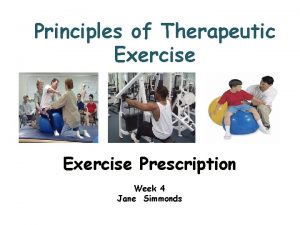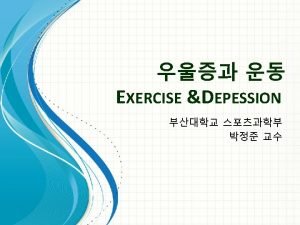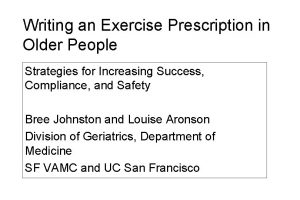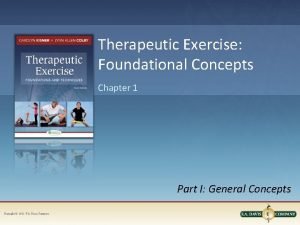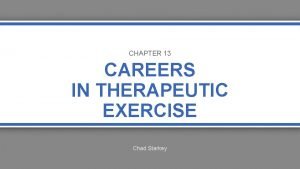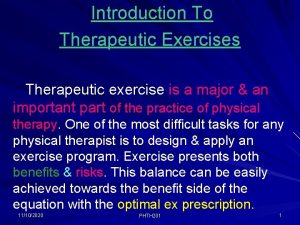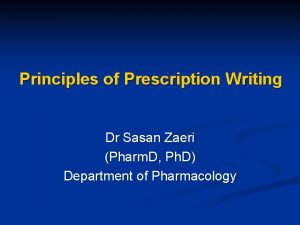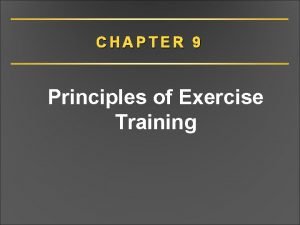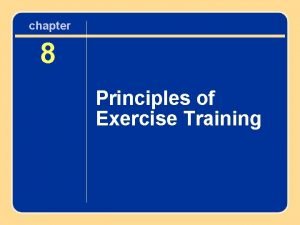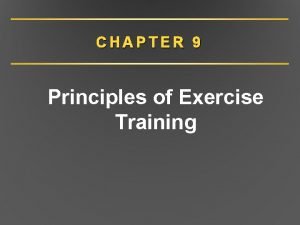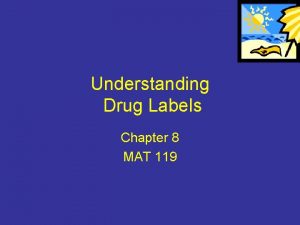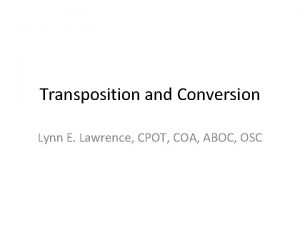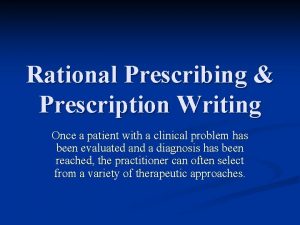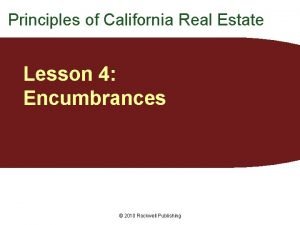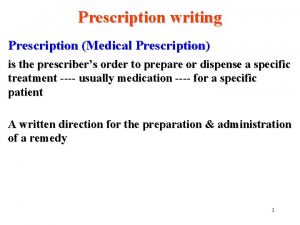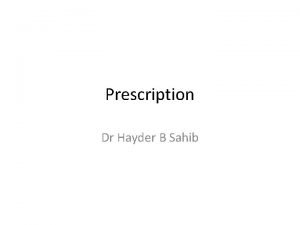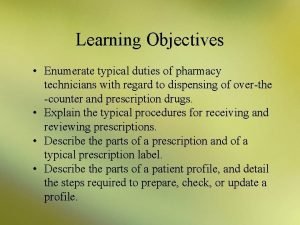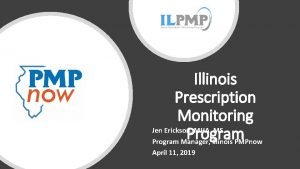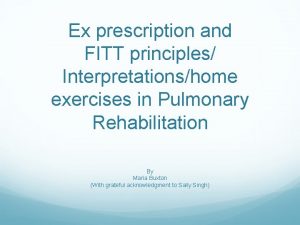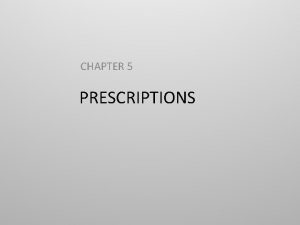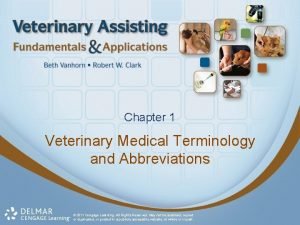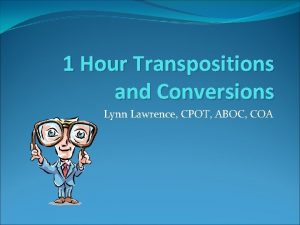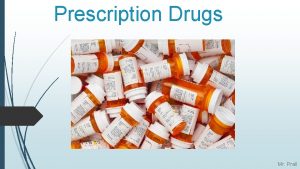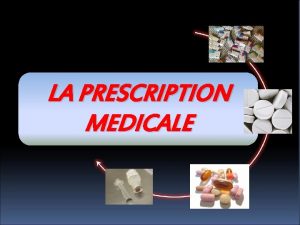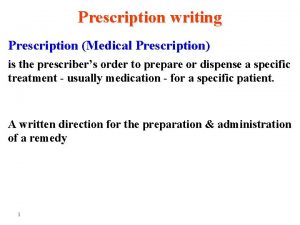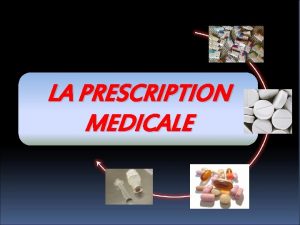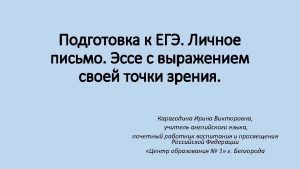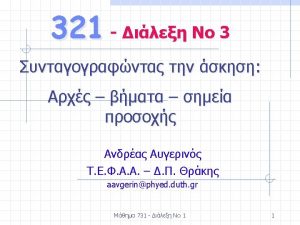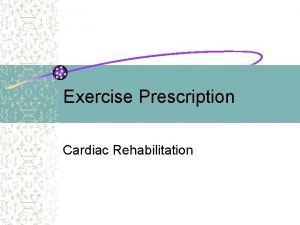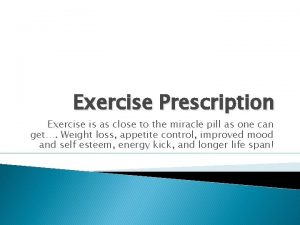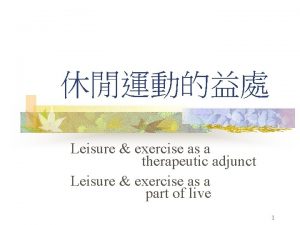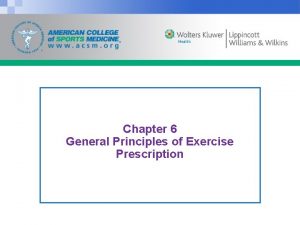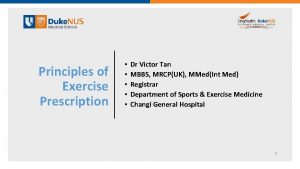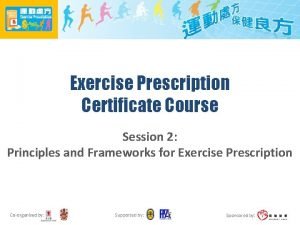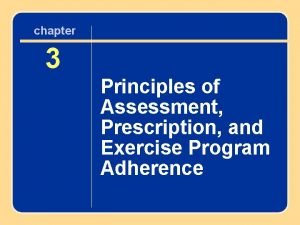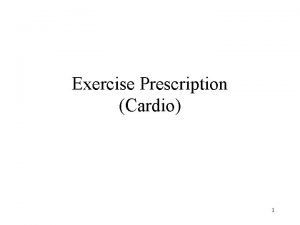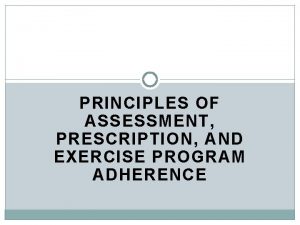Principles of Therapeutic Exercise Prescription Week 4 Jane






























- Slides: 30

Principles of Therapeutic Exercise Prescription Week 4 Jane Simmonds

Format • Exercise in the context of the physiotherapy profession and practice • Review the principles of training • Review the different types of exercise • Explore the concept of exercise prescription for the prevention and management of diseases and disorders • Review muscle physiology

Learning Outcomes • By the end of the session and independent study you should; – Understand the cope of exercise used in physiotherapy practice – Understand the principles of training – Understand the concept of training variables

Core Skills - Physiotherapy • • Movement analysis Manual therapy Electrotherapy Exercise therapy – exercise prescription (ACPET)

Exercise for the prevention of disease • Relationship between a sedentary lifestyle and chronic degenerative disorders • More than 20 disorders related to inactivity • 50 years of research – Seminal research bus conductors – Parffenbarger’s research • Physiotherapists have a role to play in health promotion Morris & Crawford 1958

Therapeutic Exercise • Prevent or rehabilitate disabilities • Improve or restore physical function so that ADL’s are no longer a challenge • Improve overall health and fitness • Reduce risk factors Rehabilitation Cycle Functional fitness and rehabilitation Early to middle management

Which patients groups benefit from therapeutic exercise? • • • Cardiac patients Orthopaedic patients Amputees General surgical Neurological Elderly Learning disabilities Psychiatric Palliative care • • • Respiratory Paediatric Rheumatology Musculo-skeletal Occupational Spinal injuries Obstetrics Gynacological Burns and plastics

Aims of Therapeutic Exercise • • • Enable ambulation Release contracted soft tissues Mobilise joints Improve circulation Improve respiratory capacity Decrease stiffness

Aims of Therapeutic Exercise • • • Improve muscle strength Improve endurance Improve co-ordination Promote confidence and wellbeing Improve balance Promote relaxation

Overarching Goal • To try whenever possible to restore full function and achieve an optimal level of physical fitness. • Achieve this by setting shared realistic goals and identifying how fit the client needs to be. • Motivation • Adherence, compliance and concordance

Designing Exercise Programmes • When designing an exercise programme consider; • Pathology • Person (age, personality – psychology) • Needs - aspirations • Environment • Physiological processes • Principles of training

Types of Exercises • Stretching • Range of movement exercises • Strengthening exercises • Endurance exercises • Proprioceptive or balance training • Cardio-vasacular training

Principles of Training • • Readiness Overload Specificity Motivation Learning Reversibility Diminishing returns

Prescription Variables • • • 5 key components Frequency Duration Intensity Type of exercise Progression

Stretching • Passive or active • Stretching to retain range e. g. joint pathology • Stretching to increase normal range e. g. sport and dance • Stretching to lengthen contracted, fibrosed, shortened tissue e. g. congenital conditions, postsurgery/immobilisation/inju ry • How long should we stretch for?

Mobility Exercises • Active assisted Ø Usually used as interim measure moving from passive to active, also when joint pain limits free active movement • Free active • Knowledge of aging and pathologies required to prevent undesirable movements e. g. trunk flexion exercises in osteoporosis

Cardio-respiratory Exercise • Aerobic exercise positive influence on risk factors in CVD, diabetes, weight control and cancer. • Rehabilitation programmes for cardiac and pulmonary patients • Incremental monitored progression of exercise • Early on: exercise not more than 20 bpm above resting level and not more than 11 -12 on RPE (40% Vo 2 max) • 40 -80% MHR depending on fitness (MHR =220 -age) • Isometric exercises for vulnerable patients advise isometric contraction ≤ 6 secs each

Monitoring • Why is monitoring important? • Heart rate ØPulse monitor, ECG, chest strap • Blood pressure ØSystolic/diastolic • Subjective measure ØRating of perceived exertion (RPE)

Borg Scale

Proprioception • Essential post-injury especially lower limb • Retraining for amputees and neuro patients • Elderly rehab, altered joint biomechanics in OA. ? May prevent falls

Muscle Contractions and Resistance Exercises • Consider why we might choose these different types of exercises? • Are there any risks? • Isometric • Concentric • Eccentric • Isokinetic • Closed and open chain exercises

Strength, Power and Endurance • • • What is the difference? Load (resistance) Repetitions Sets Frequency Consider muscle fibre type

Muscle Fibre Types • Skeletal muscle fibers are classified into two major categories; slow-twitch (Type 1) and fast-twitch fibers (Type II). • The difference between the two fibers can be distinguished by; – metabolism – contractile velocity – neuromuscular differences – glycogen stores – capillary density of the muscle – and the actual response to hypertrophy

Fibre Type • Slow twitch – type 1 – – – Rich in haemaglobin Mitochondria Rich in blood vessels Red Common postural muscles. • Slow twitch – type II • Type II a - fast oxidative fatigue resistant – fast oxidative fibres • Type II (b)x - fast glycolytic fibres - split ATP at a fast rate and have a fast contraction velocity.

Progressing Exercise • • Overload principle Motivation principle Strength? Endurance? Power? Complexity of task Functional

Exercise Prescription • Exercise prescription is based on physiological principles and laws of training and modified by clinical findings. – Pain – Underlying medical conditions – diabetes, cardiovascular disease, diabetes, psychological factors etc. – Safety

Exercise prescription requires a detailed knowledge of; • • • Motor learning Anatomy Biomechanics/pathomechanics Kinesiology Pathology Exercise physiology

Exercise Psychology • Adherence, compliance and concordance • Goals • Patient factors: age, sex, socio-economics, fear, self-efficacy, support • Programme factors: personnel, education, attention, group dynamics, logistics

Summary • Exercise prescription is a core skill for physiotherapists • Underpinned by physiological and patho-physiological processes • Requires a good understanding of exercise physiology and the principles of training • Motivational psychology - stages of change • Imagination

References • Hanandez Kravitz (2006) http: //www. unm. edu/~lkravitz/Article%20 folder/hypertrophy. html • Robergs, R. A. and S. O. Roberts(1997) Exercise Physiology: Exercise, Performance, and Clinical Applications. Boston, WCB Mc. Graw-Hill • National Institute on Aging (2005) www. niapublications. org/exercisebook/chapter 4. htm. • Skinner JS (2005) Exercise Testing and Exercise Prescription for Special Cases. Philadelphia, Lippincott, Williams & Wilkins • Woolf-May K (2006) Exercise Prescription – physiological foundations. Churchill Livingstone
 Principles of therapeutic exercise
Principles of therapeutic exercise Exercise prescription example
Exercise prescription example How to write an exercise prescription
How to write an exercise prescription Therapeutic exercise chapter 1 mcqs
Therapeutic exercise chapter 1 mcqs Classification of therapeutic exercise
Classification of therapeutic exercise What is habilitative exercise?
What is habilitative exercise? Therapeutic exercise definition
Therapeutic exercise definition Levothyroxine classification
Levothyroxine classification Dr.sanjeewani fonseka
Dr.sanjeewani fonseka Principles of prescription writing
Principles of prescription writing Characteristics of therapeutic communication
Characteristics of therapeutic communication Week by week plans for documenting children's development
Week by week plans for documenting children's development 9 principles of exercise
9 principles of exercise General principles of training
General principles of training 9 principles of training
9 principles of training Dental laboratory work authorization forms
Dental laboratory work authorization forms Parts of a drug label
Parts of a drug label Cylinder transposition
Cylinder transposition Elements of a prescription
Elements of a prescription Servient tenement
Servient tenement Costco bendigo
Costco bendigo Ac iv medical abbreviation
Ac iv medical abbreviation Medication order sample
Medication order sample Prescription label parts
Prescription label parts Illinois controlled substance monitoring
Illinois controlled substance monitoring Fitt prescription
Fitt prescription Elements of a prescription
Elements of a prescription Cengage medical terminology chapter 1
Cengage medical terminology chapter 1 Nvo eye prescription
Nvo eye prescription Prescription parts
Prescription parts Local 237 union
Local 237 union
